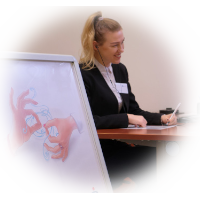Employment
The Bank pays close attention to the satisfaction of its employees with their employment in the company. This is facilitated by a fair and transparent remuneration system, a package of non-salary benefits, and by taking into account the development needs of employees, and creating a friendly and cooperative work environment. In accordance with the employment policy, all employees are treated equally regardless of their gender, age, disability, race, religion, nationality, political beliefs, trade union membership, ethnic origin, health condition, sexual orientation, marital status, full- or part-time employment status.
Key non-financial performance indicators in the area of employment (in per cent) COMMITMENT BY 2025 | INDICATOR | 2023 | 2022 | Increase in the proportion of women in management positions to >40% | Share of women in management positions | 38.7 | 38.7 | Increase the proportion of women in MRT positions in the Bank to >30% | Share of women in MRT positions in the Bank | 22.7 | 20.6 | >2% participation of people with disabilities among employees | Share of people with disabilities among employees | 1.2 | 1.2 | Closing the gender pay gap | Gender pay gap | 2% | 4% | <7% voluntary departure rate | Voluntary departure rate | 5.4 | 7.9 | <14% ratio of total employee turnover | Ratio of total employee turnover | 10.0 | 13.4 |
|
[GRI 2-7] At the end of 2023, the employment within the Group amounted to 25,601 full-time equivalents, representing an increase of 529 FTEs compared to the end of 2022. The increase in employment is due to the implementation of new initiatives as part of the adopted strategy. The majority of employees are women (71% within the group, 73% within the Bank), while the largest age cohort includes employees aged 30-50 years old (63% and 61% in the group and in the Bank respectively). Most employees are employed on a full-time basis, while women are more likely to work part-time.
| | | | | | |
| | 97% | | 73,4% | | 10% |
| | Percentage of roup employees employed full-time | | Group's employees with >10 years of service
| | Employee turnover
rate in the Bank [GRI 401-1] |
Structure of employment by job type, age, employment contract and gender in 2023
| Bank |
| 2023 | 2022 |
| total | woman | men | total | woman | men |
by position and gender | | | | | | |
regular employees | 86,4% | 74% | 26% | 86,4% | 75% | 25% |
middle menagment | 7,4% | 64% | 36% | 7,8% | 64% | 36% |
managers | 5,9% | 59% | 41% | 5,5% | 59% | 41% |
MRT (Material Risk Takers) | 0,3% | 23% | 77% | 0,3% | 23% | 77% |
total | 100% | 73% | 27% | 100% | 74% | 26% |
by age group and gender | | | | | | |
up to 30 years | 12% | 68% | 32% | 11% | 71% | 29% |
from 30 to 50 years | 61% | 71% | 29% | 62% | 71% | 29% |
above 50 years | 27% | 79% | 21% | 27% | 80% | 20% |
total | 100% | 73% | 27% | 100% | 74% | 26% |
by full-time and part time emloyment and gender | | | | | | |
full-time | 99% | 73% | 27% | 99% | 73% | 27% |
part-time | 1% | 79% | 27% | 1% | 78% | 22% |
by agreement terms | | | | | | |
indefinite period | 87% | 13% | 28% | 87% | 73% | 27% |
definite period | 13% | 74% | 26% | 13% | 76% | 24% |
by region | | | | | | |
in UE countries | 100% | 73% | 27% | 100% | 74% | 26% |
in third countries (Ukraine) | - | - | - | - | - | - |
Total employment | 100% | 73% | 27% | 100% | 74% | 26% |
| The Bank's Group
|
| 2023 | 2022 |
| total | woman | men | total | woman | men |
by position and gender | | | | | | |
regular employees | 85,6% | 73% | 27% | 85,6% | 74% | 26% |
middle menagment | 7,5% | 62% | 38% | 8% | 62% | 38% |
managers | 6,3% | 55% | 45% | 6,0% | 55% | 45% |
MRT (Material Risk Takers) | 0,5% | 25% | 75% | 0,5% | 24% | 76% |
total | 100% | 71% | 29% | 100% | 72% | 28% |
by age group and gender | | | | | | |
up to 30 years | 12% | 68% | 32% | 12% | 70% | 30% |
from 30 to 50 years | 63% | 70% | 30% | 64% | 70% | 30% |
above 50 years | 25% | 77% | 23% | 24% | 80% | 20% |
total | 100% | 71% | 29% | 100% | 72% | 28% |
by full-time and part time emloyment and gender | | | | | | |
full-time | 99% | 73% | 27% | 97% | 72% | 28% |
part-time | 1% | 78% | 22% | 3% | 64% | 36% |
by agreement terms | | | | | | |
indefinite period | 97% | 72% | 28% | 87% | 72% | 28% |
definite period | 17% | 70% | 30% | 13% | 75% | 25% |
by region | | | | | | |
in UE countries | 94% | 71% | 29% | 94% | 72% | 28% |
w państwach trzecich (Ukraina) | 6% | 71% | 29% | 6% | 69% | 31% |
Zatrudnienie ogółem | 100% | 71% | 29% | 100% | 72% | 28% |
The share in the number of employees of a given gender and/or in the total number of employees Only employees with an employment contract are included.
[GRI 401-3] In 2023, parental leaves were predominantly taken by women. The return-to-work rate after parental leave was 81% for women (95% for men), with 86% of women remaining in employment until the end of 2023 (50% for men).
Returns to work after parental leave in 2023 [GRI 401-3]
| | Bank | Group |
Parental leave:
| women | men | women | men |
| employees eligible for parental leave in the reporting year 2023 | 476 | 93 | 593 | 121 |
| employees who took parental leave in 2023 | 509 | 19 | 679 | 26 |
| employees who returned to work in the reporting year after parental leave ended in 2023 | 414 | 18 | 514 | 24 |
| employees who returned to work after parental leave ended, that are still employed 12 months after their return to work | 453 | 3 | 523 | 4 |
| return to work rate: share of return to work after the parental leave | 81% | 95% | 76% | 92% |
| retention rate: share of employees who returned to work after the parental leave and stayed employed | 86% | 50% | 84% | 67% |
Salaries
[GRI 2-30] The Bank operates under a Collective Bargaining Agreement negotiated with the company’s trade union organizations, which regulates, among other things, renumeration matters. In accordance with the Agreement, bank employees are entitled to the following components of renumeration: (1) basic salary, (2) allowances for working overtime and in conditions particularly onerous and harmful for their health, (3) bonuses and rewards for extraordinary achievements in professional work. Basic salaries and additional benefits are set on the basis of regular job valuations and analysis of market salaries. Employee bonus targets are linked to the bank's key management indicators. The employee remuneration policy ensures a consistent salary system by:
- Adhering to a compensation system aligned with market trends,
- Attracting optimal candidates for employment,
- Adjusting mechanisms, tools, and levels of compensation to the bank’s strategy and objectives, as well as those of the bank’s Capital Group,
- Considering the capabilities of the Bank’s Capital Group in shaping desired compensation mechanisms and levels,
- Shaping fixed wages based on job valuation,
- Structuring compensation based on work performance and employee competency assessments,
- Instilling in employees a sense of responsibility for tasks performed, evaluated based on objective criteria,
- Ensuring that variable compensation components are parametrized to account for the costs of risk, cost of capital, and liquidity risk of the bank and its Capital Group in the long term,
- Ensuring a system in which forms of compensation do not incentivize individuals involved to favour their own interests or the interests of the bank and other entities within the Capital Group to the detriment of customers.
The key activities related to the Bank’s employee compensation plan in 2023 included:
- global wage adjustment campaign linked to tenure,
- one-time reward initiative,
- sales-oriented competition initiatives for employees of selected organizational units, particularly those within the retail network.
The ratio of the average weighted salary for women and men by job groups in the Bank (%)
| | 2023 | 2022 | 2021 |
| Distrinution network | 101 | 98 | 97 |
| Other non-menagerial positions | 96 | 94 | 93 |
| Middle management | 96 | 95 | 95 |
| Managers | 97 | 97 | 97 |
| MRT | 98 | 93 | 84 |
| Total: | 98 | 96 | 95 |
[GRI 405-2] In 2023, the global gender pay ratio, calculated as the weighted average of total compensation paid to women compared to men, was 98% in the Bank and 97% in the Bank’s Capital Group
The gender pay gap, calculated on the basis of the weighted average compensation, was 2% for the Bank and 3% for the Bank’s Capital Group. The gender pay gap at the Bank was 1.6%.
The calculation of the gender pay ratio is based on comparing salaries in distinct homogenous groups, weighted by the size of these groups. These groups consist of employees with identical job valuations, job families, and geographical locations. The Bank’s remuneration policy does not discriminate against any gender. The process of determining salaries is based on job valuation results, considering the complexity of tasks within a particular organizational structure, the level of responsibility associated with the position, and necessary skills.
The pay disparity ratio, calculated according to the methodology outlined in the guidelines for the Best Practices for WSE Listed Companies 2021, totalled 31.7% for the Bank. This ratio is calculated as the percentage difference between the average monthly total salary of all women and men for the year 2023. It does not account for employment structure, job valuation levels, job families, or geographical locations, all of which, regardless of gender, influence employee renumeration. The presented level of gender pay gap does not indicate any unjustified inequalities in the amounts of compensation between women and men. The causes of gender-related deviations stem from the nature of the organization, where the workforce is predominantly female.
The Bank performs regular salary reviews for different positions, including gender-specific considerations, and incorporates internal benchmarks as well as data from remuneration reports and renumeration surveys in the renumeration strategy shaping and optimization process.
In order to ensure comparability of the same positions and eliminate the total impact of other elements on the salary level, the Bank also uses the CR (Comparatio) ratio as a comparability indicator – comparing the compensation offered to employees within the appropriate market benchmark. Internal analyses using the CR ratio indicate there are no gender- based differences in remuneration within the Bank, and both groups receive remuneration at the market level.
[GRI 2-21] The ratio of the highest total remuneration paid in 2023 to the median annual total remuneration of all employees (excluding the highest salary) is 10.6.
The ratio of the percentage increase in the highest total compensation paid in 2023 within an organization to the percentage increase in the median annual total remuneration for all employees (excluding the highest salary) is 0.68.
The above ratios were calculated based on the total remuneration paid in 2023 to employees employed under employment contracts, i.e. excluding the total remuneration paid to members of the Management Board under managerial contracts.
Additional information about employment at the bank
| Employment: | 2023 | 2022 | 2021 | 2020 |
| on permanent contract (share in total employment) | 86,8% | 87,4% | 88.2% | 89.5% |
| on fixed-term contract (share in total employment), including: | 13,2 % | 12,6% | 11.8% | 10.5% |
| - contracts for replacement | 1,8 % | 1,6% | 1.9% | 1.5% |
| share of employees with duration of employment >10 years (in total employment) | 73,4% | 51,6% | 74.0% | 74.9% |
| average duration of employment for women (in years) | 15 | 16 | 16 | 16 |
| average duration of employment for men (in years) | 12 | 12 | 11 | 11 |
| number of women employed (in thousand) | 16 | 15 | 16 | 16.4 |
| number of employees in senior management roles (in thousand) | 1,3 | 1,2 | 1.2 | 1.2 |
| number of women in senior management roles (in thousand) | 0,8 | 0,7 | 0.7 | 0.7 |
| number of new hires (in thousand) | 2,5 | 2,4 | 2.4 | 1.0 |
| number of women among the new hires (in thousand) | 1,6 | 1,7 | 1.7 | 0.7 |
| share of employees with disabilities (in total employment) | 1,2% | 1,2% | 1.2% | 1.2% |
[GRI 401-2]
In order to maintain our employees’ satisfaction, we also provide non-wage benefits, which are available to all employees regardless of their employment contract or working hours. It is essential for the Bank to align these benefits with market trends, as such actions are closely linked to shaping the brand’s image as a good employer. The main additional benefits provided to employees include free medical care (including the annual prevention program “Bank-guaranteed health” focused on early disease detection and promoting a healthy lifestyle, as well as additional tests to detect complications from COVID-19), the Employee Pension Program (EPP) where employees can save additional funds to supplement retirement income from mandatory pension schemes, a cafeteria system on the MyBenefit platform, and sports cards. The catalogue of additional benefits offered includes product offers and discounts for bank employees, vouchers, group insurance, development and training programs, support for employees’ sports and charity activities and initiatives.
Employee training and internal communication
[GRI 404-2] Development activities are tailored to the specific nature of the Bank and the individual entities of the Bank’s Capital Group as defined by internal regulations. This ensures a flexible approach to the development policy.
“The Manner of Organizing and Implementing Development Activities in PKO Bank Polski S.A.” defines the goals, directions, and actions of the Bank in managing the development of employees or other collaborators of the bank. The main assumption of the adopted training policies are:
- supporting the achievement of the strategic goals of the entities of the Bank’s Group and the business objectives,
- onboarding new employees,
- providing professional qualifications to employees and adapting their knowledge and skills to the changing requirements of the market requirement of the respective entity,
- preparing employees for the implementation of new solutions and products offered by entities of the Bank’s Group and/or for introducing changes to the existing solutions and/or products offered.
All employees, regardless of age or gender, can benefit from training activities within the Bank’s Group. Individual entities may use the criterion of the occupied position when directing employees to specific training, such as participation in education at the higher education level (various levels of education in the individual entities of the Bank’s Group) or foreign language courses. Employers fully or partially finance training activities.
The Bank updates and communicates the Training Catalogue quarterly on the intranet portal. The catalogue contains a range of development activities and an easy-to-use tool for signing up for specific training sessions.
The Bank conducts development projects for both hard and soft skill formats. A team of internal trainers conducts group training, job-specific training, and internal workshops, including those for interns. Group training is provided by external companies on selected projects. The Digital Transformation employees have access to both internal training courses in agile methodology and to certified training courses. Employees also benefit from language courses.
Employees actively use the internal e-learning platform very, mainly for product knowledge, process, and IT application training.
As part of their professional development, employees can apply for funding for postgraduate studies, Master of Business Administration (MBA) studies, legal traineeships, and language courses. The Bank also implements adaptive programs tailored to the specificity of individual business areas. Training in the Bank is available to employees regardless of employment form (permanent or contract).
| | | | |
| | 17h | | 79% |
| | Average hours of training
per year per employee [GRI 404-1] | | Employees receiving regular performance
and career development reviews [GRI 404-3] |
Principles for employee development and succession planning at PKO Bank Polski are defined by the goals, directions, and management approach to employee development. The main assumption in the adopted training policies is to support the achievement of the strategic and business objectives of group entities, onboard new employees, provide professional qualifications of employees and adaptation of their knowledge and skills to changing market requirements and entity-specific operating environments, and preparing employees for implementation of new solutions and products offered by the group's entities or changes to the existing solutions and products offered.
Bank employees can access all information regarding personnel matters in one place – by contacting the HR Contact Center. The team of consultants handles inquiries related to payroll and personnel administration, social affairs, recruitment, and training. This solution accelerates and simplifies the communication process between employees and the HR units responsible for personnel management.
|
In 2023, #ESGo development program was initiated. The program aims to educate all employees in the field of sustainable development. Building competencies in both core and expert areas is expected to enable the effective transformation of the bank’s ESG practices. In 2023, 293 employees participated in the ESG training sessions, with 1,923 employees attending the meetings online. Participants learned about ESG principles, became familiar with the Bank’s strategic ESG goals, and explored the role of the Bank as a financier of ESG transformation in Poland. Bank employees also enhance their qualifications in the ESG field through postgraduate studies. The goal of these studies is to translate the requirements of sustainable development and ESG into Bank’s operations, acquire knowledge about portfolio monitoring and the ESG requirements that clients are expected to meet.
As part of the partnership, between the Bank, Group companies, and the PKO Bank Polski Foundation, an eco-volunteering program for employees was implemented. Clients, retired employees, local authorities, and educational institutions were invited to collaborate. The project was nationwide.
Recruitment policy
The recruitment policy within the Bank’s Capital Group is focused on hiring individuals with diverse experiences and professional competencies based on high standards of anti-discrimination and personal data protection. Discriminatory criteria (such as age, gender, disability, race, religion, nationality, political beliefs, union membership, sexual orientation, ethnic or social origin) are not applied in the process of selecting employees. Recruitment processes are supported by modern tools and information systems.
The Bank actively supports and promotes internal mobility among employees through internal information campaigns, internal job fairs, and consultations with recruiters to encourage employees to participate in the internal recruitment process (across the Bank’s Capital Group) as part of professional development in other business areas. In addition, it ensures an optimal transition period for employee selected in internal recruitment to their new units. This ensures a quick and smooth process.
For years, the Bank has been developing its internship programme devoted for students and graduates - #StażNaDzieńDobry. Participants in this programme can develop their career in their chosen area of the Bank Group's business. In 2023, three new editions of the internship programme were launched:
- #StażNaDzieńDobry - Corporate Customer segment,
- #GenESG – Internships in the area of ESG and sustainable development,
- #ZaRyzykuj – Internships in the area of risk management.
The Bank regularly conducts surveys to improve the recruitment process of external and internal candidates.
An internal recommendation program is in place allowing employees to recommend candidates for employment. If the recommended candidate is hired and meets the conditions specified in the regulations, the referring employee receives a monetary reward. In 2023, the program covered all positions in the Bank, and the reward amount for hiring candidates for key positions was increased.
An important aspect of building an employer’s image is cooperation with universities. In response to business needs, the Bank collaborates with the academic community, participating in events organized by universities. It actively engages with career offices to promote job offers and internships, organizes workshops, lectures, and sponsors selected study programs to share knowledge and strengthen cooperation with the academic community.
Trade unions and occupational health and safety (OHS)
Employee representation consists of Trade Unions and the Bank’s Employee Council. Three in-house union organizations operate in the Bank: (1) the National Trade Union of Employees of PKO Bank Polski S.A. (a representative union under the Trade Union Act), (2) the Independent Self-Governing Trade Union “Solidarność” of Employees of PKO Bank Polski S.A., and (3) the Inter-Company Organisation of Banking and Service Employees No. 06-005 OPZZ “Konfederacja Pracy”. Cooperation with these organisations is conducted in accordance with applicable regulation, including providing information, conducting consultations, or making arrangements depending on the subject matter and legal requirements. For example, consultations are conducted in the case of planned organizational changes resulting in significant changes in work organization, employment size, and basis. The employer does not impede employees from joining or participating in trade unions.
[GRI 407-1] In 2023, no operations or suppliers with high risk of restricting the freedom of association and collective bargaining were identified. No collective disputes were recorded within the capital group entities.
|
Employees have the opportunity to report grievances regarding violations of employee rights and other irregularities. [GRI 403-4] This is regulated by a grievance reporting procedure. Meetings with Trade Unions and the Bank’s Employee Council are organized when necessary, at least several times a year. Information about planned organizational changes is provided to the social side without undue delay. [GRI 402-1]. The most frequently discussed issues in 2023 concerned employee remuneration and other employment benefits.
| | | | | |
12.6% | | 100% | | 78 |
Employees who are Trade Union members | | Newly-hired employees who received
an up-to-date OHS training
[GRI 403-5] | | Work-related injuries reported
in the group in 2023 (2022: 68) [GRI 403-9] |
All subsidiaries of the Bank carry out occupational health and safety (OHS) tasks in accordance with applicable legal regulations. These regulations are so unambiguous that, in fact, they entail the application of the same occupational health and safety principles throughout the Bank’s Capital Group. Other entities located outside the borders of the Republic operate according to the rules applicable to the country in which the entity is registered.
[GRI 403-8] The basic occupational health and safety management system resulting from general provisions of law covers 100% of employees.
[GRI 403-1] The occupational health and safety service in the Bank is organized within the structures of the Administration Department as the Office of Occupational Safety and Health. It includes field teams serving all Bank units nationwide, including periodic occupational risk assessment, analysis of past accidents and incidents, monitoring potentially accident- prone events, ongoing and periodic occupational health and safety inspection in all Bank branches and units, and conducting training sessions.
[GRI 403-2] There are no positions in the Bank classified as high-risk. The main hazards identified in the occupational risk assessment include: falls and impacts on stationary objects, inadequate lighting, overload of the musculoskeletal system and visual organ, electric shock and traffic accidents. Due to predominance of administrative- office positions, the hazards identified within the group are consistent with those assessed in the Bank.
[GRI 403-7] Preventive actions taken to improve safety and conditions arising from employment relationships include: support and determination of procedures taken in case of psychosocial hazards such as stress or bullying, informational campaigns concerning ergonomics and workplace safety, additional non-mandatory first aid training, safe driving courses for employees using company vehicles, eye health prevention, accident prevention, and providing personal protective equipment for positions exposed to external factors.
[GRI 403-10] All group entities have agreements with external medical facilities for occupational health examinations. The examinations are funded or reimbursed by the employer. In 2023, two proceedings were initiated regarding the occurrence of occupational diseases among former Bank employees, both proceedings are still pending by the State Labour Inspectorate and no decision has been issued in this regard. However, 6 proceedings initiated in previous years were concluded, resulting in 7 decisions.
[GRI 403-6] All entities within the Bank’s Capital Group, including the Banks, undertake additional actions for employee health: free preventive examinations (e.g. annual health check-up package, mammography or flu vaccinations), training to promote healthy lifestyle (including exercise guidelines for office workers), access to a number of sports and leisure facilities as part of each employee's benefit package, organization of sports selections, competitions, and events supporting physical activity, as well as environmental and cyclical health-promoting campaigns. Additionally, the Bank actively participates in external sports events as an organizer, patron or sponsor, enhancing its health-promoting image as an employer.









